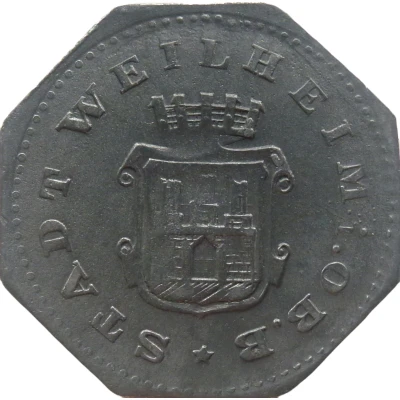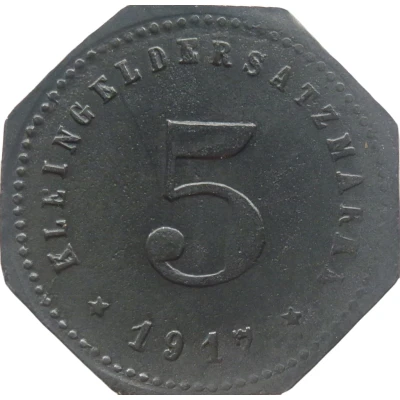


© Willem63 (CC BY-NC-SA)
5 Pfennigs - Weilheim
1917 year| Zinc | 1.7 g | 19.8 mm |
| Issuer | City of Weilheim in Oberbayern (Federal state of Bavaria) |
|---|---|
| Emperor | William II (Wilhelm II) (1888-1918) |
| Type | Standard circulation coin |
| Year | 1917 |
| Value | 5 Pfennigs (5 Pfennige) (0.05) |
| Currency | Mark (1914-1924) |
| Composition | Zinc |
| Weight | 1.7 g |
| Diameter | 19.8 mm |
| Thickness | 0.9 mm |
| Shape | Octagonal (8-sided) |
| Technique | Milled |
| Orientation | Medal alignment ↑↑ |
| Demonetized | Yes |
| Updated | 2024-10-04 |
| Numista | N#193813 |
|---|---|
| Rarity index | 89% |
Reverse
Pearl rim, legend surrounding denomination.
Script: Latin
Lettering:
KLEINGELDERSATZMARKE
5
★ 1917 ★
Edge
Plain
Comment
Issuing body: [Stadt, Bayern].Interesting fact
One interesting fact about the 5 Pfennigs - Weilheim 1917 coin is that it was issued during a time of economic turmoil in Germany, known as the "Inflationary Period" (1914-1923), when the value of the German mark dropped significantly due to excessive printing of money to finance World War I and other economic factors. As a result, many Germans turned to alternative forms of currency, such as local notgeld (emergency money) and foreign currencies, which led to the creation of unusual coins like the 5 Pfennigs - Weilheim 1917, made of zinc and weighing only 1.7 grams.